A New Earth Crustal Velocity Field Estimation from ROA cGNSS Station Networks in the South of Spain and North Africa
Abstract
1. Introduction
2. GNSS Stations and Data Processing
2.1. General Description of the Emplacements
2.2. Methodology Employed
3. GNSS Network Results
4. Discussion
5. Conclusions
Author Contributions
Funding
Data Availability Statement
Acknowledgments
Conflicts of Interest
Appendix A
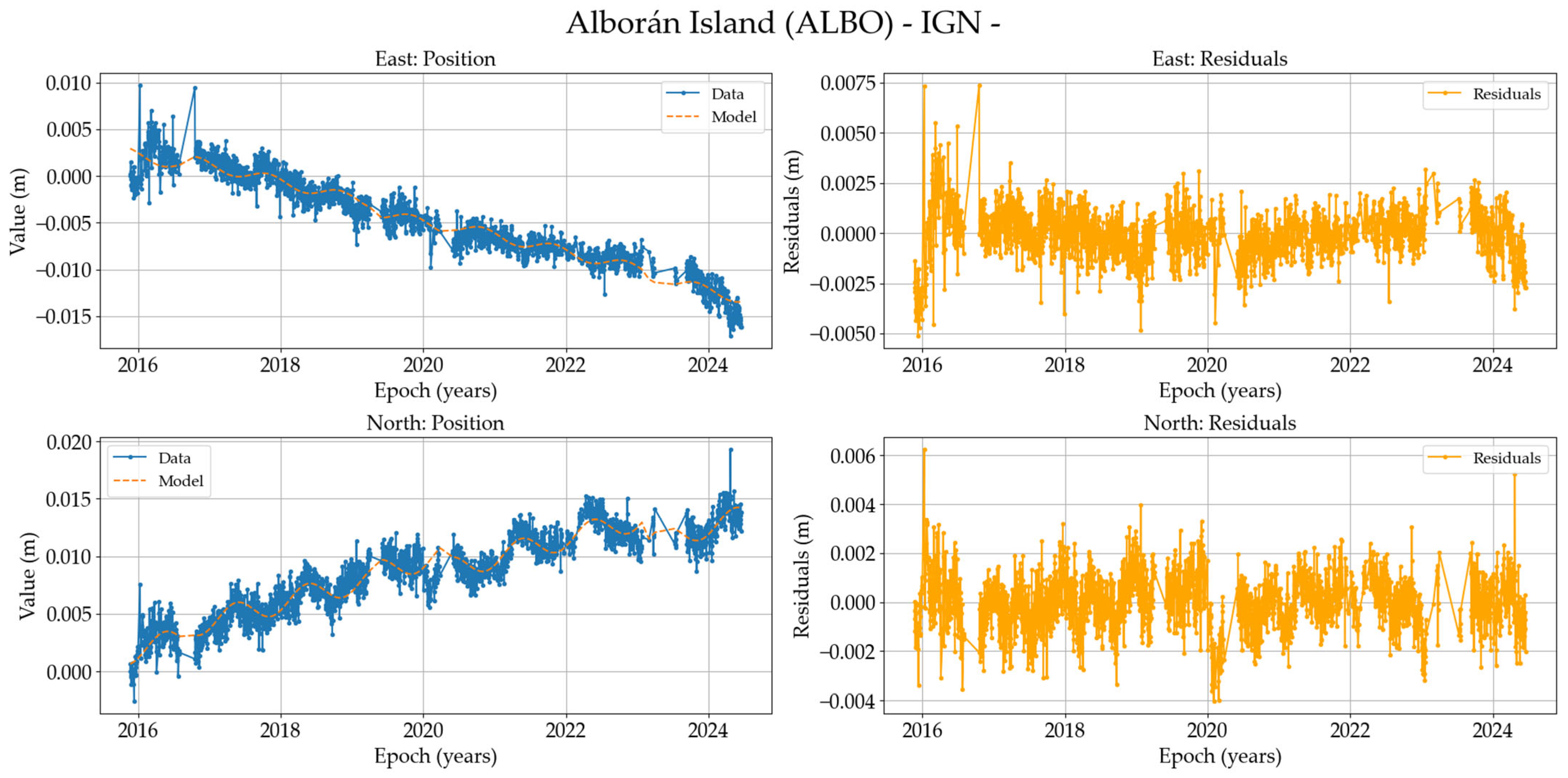
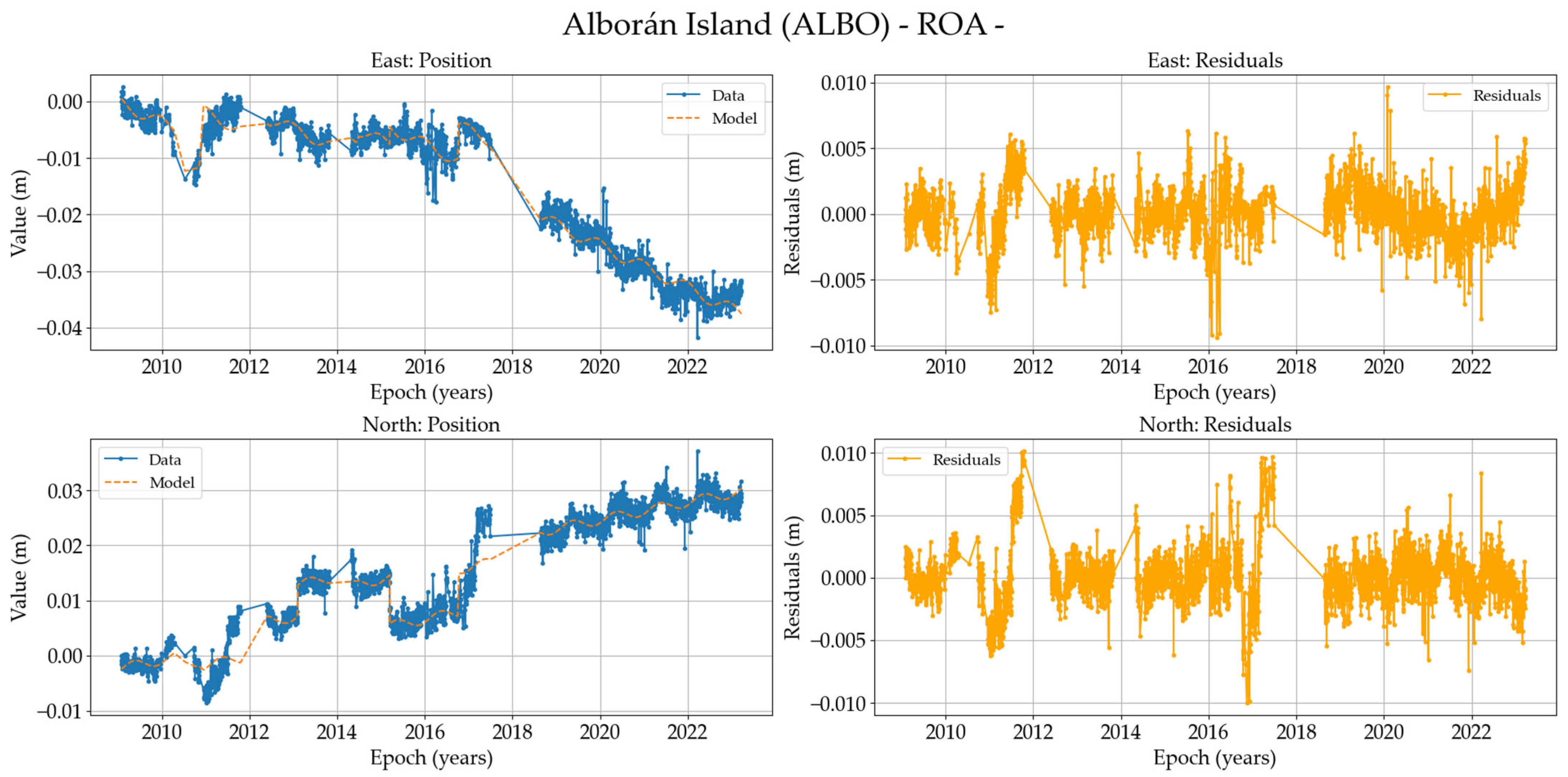

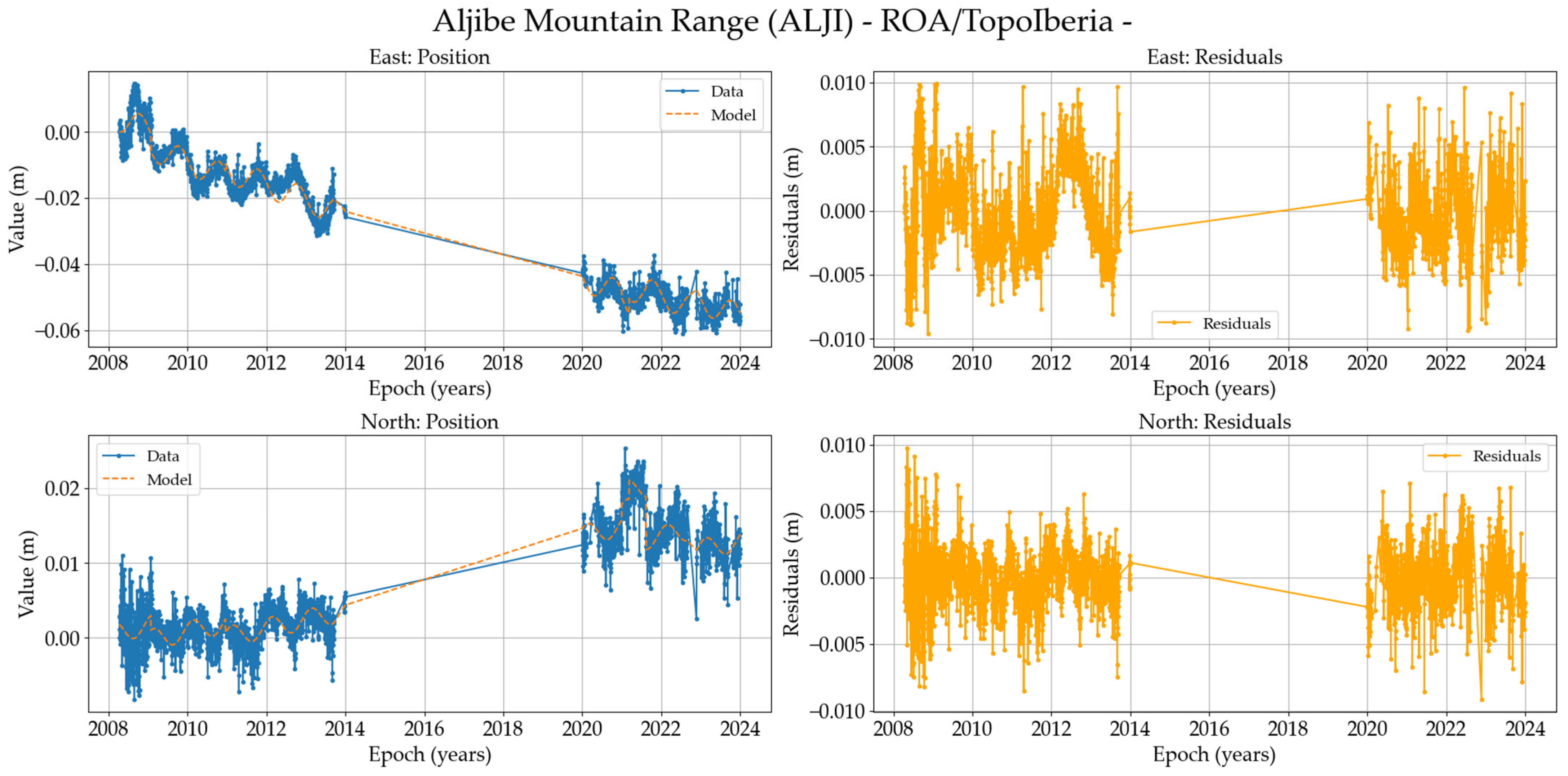
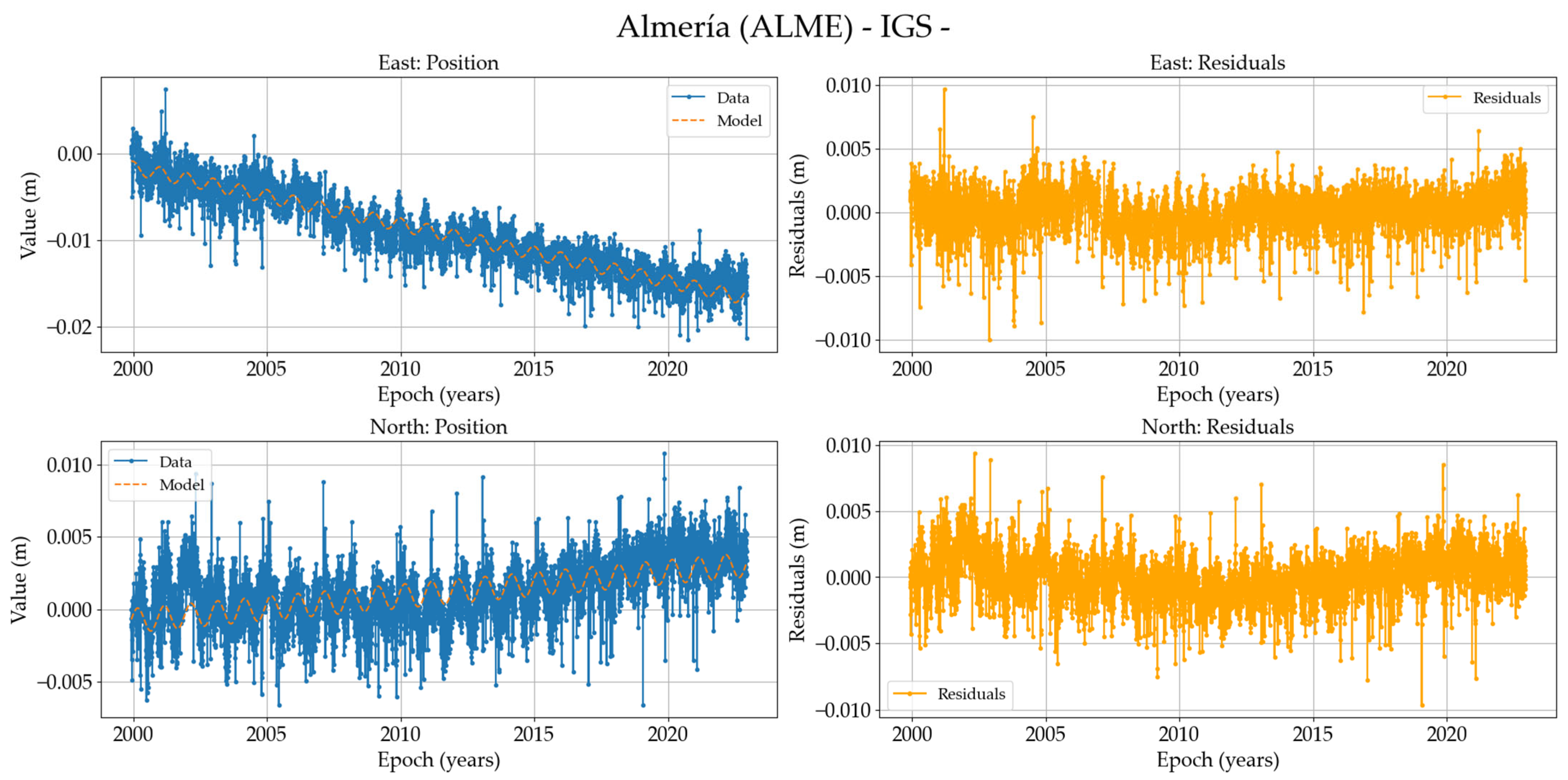



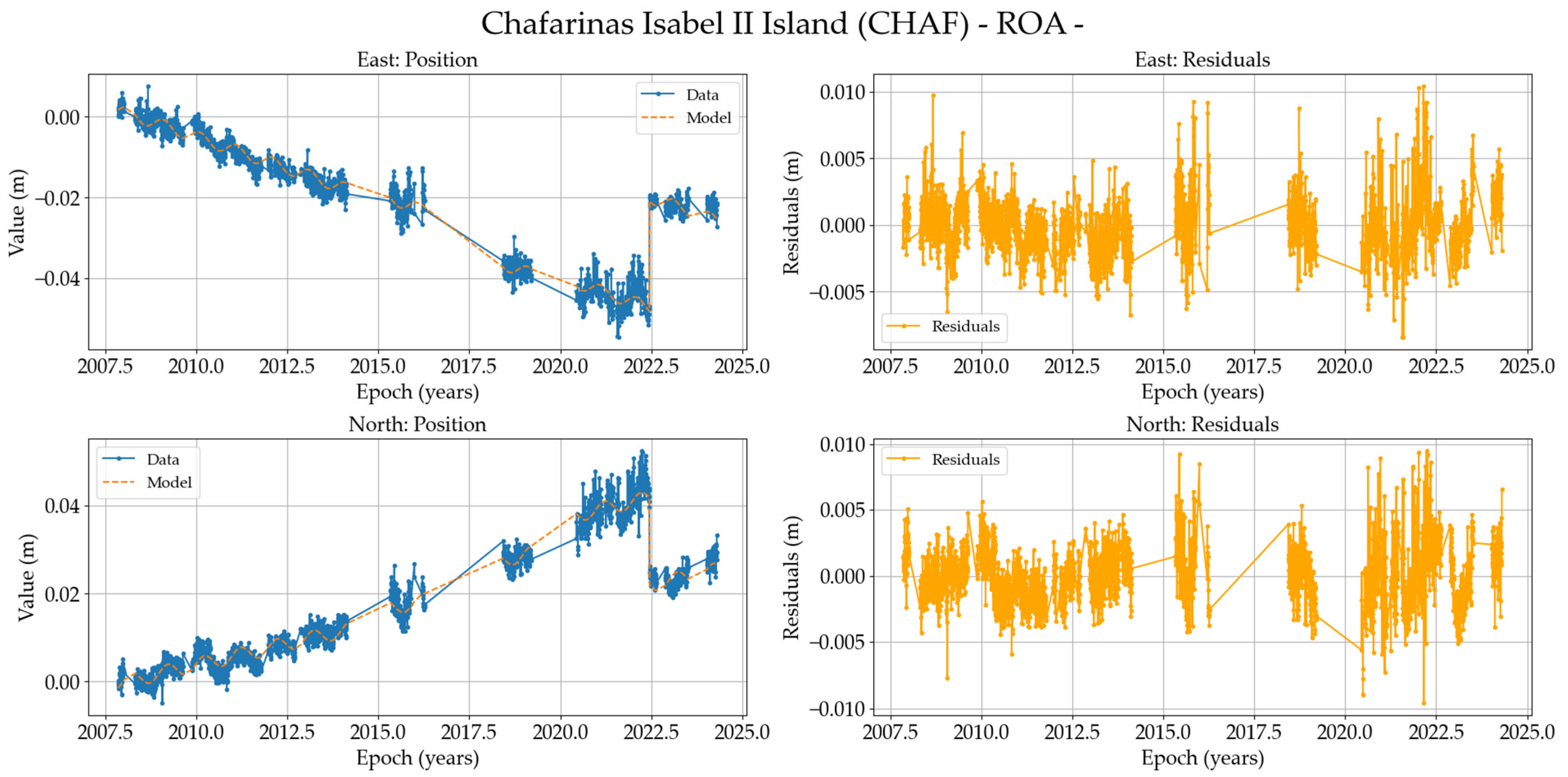

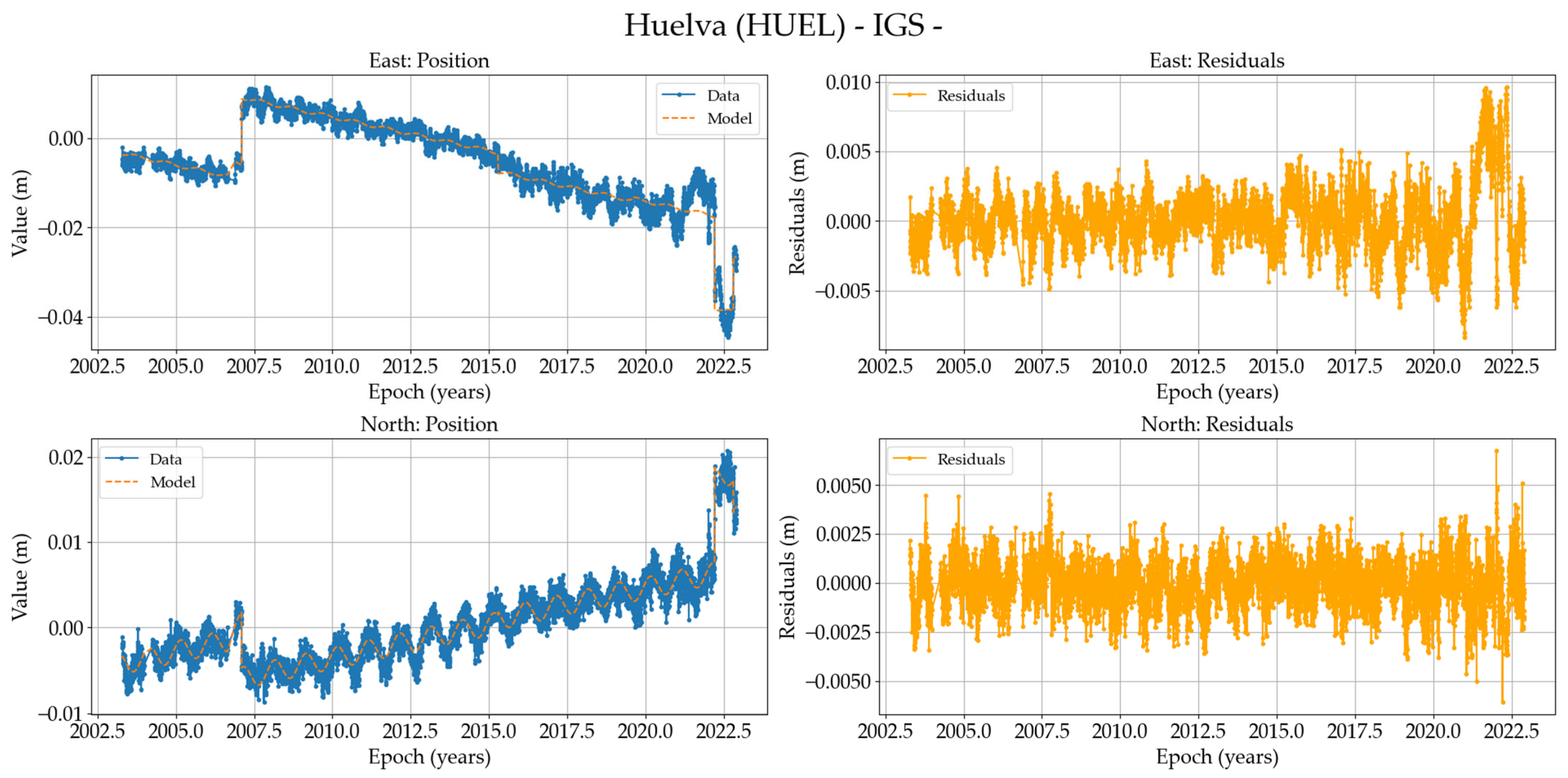

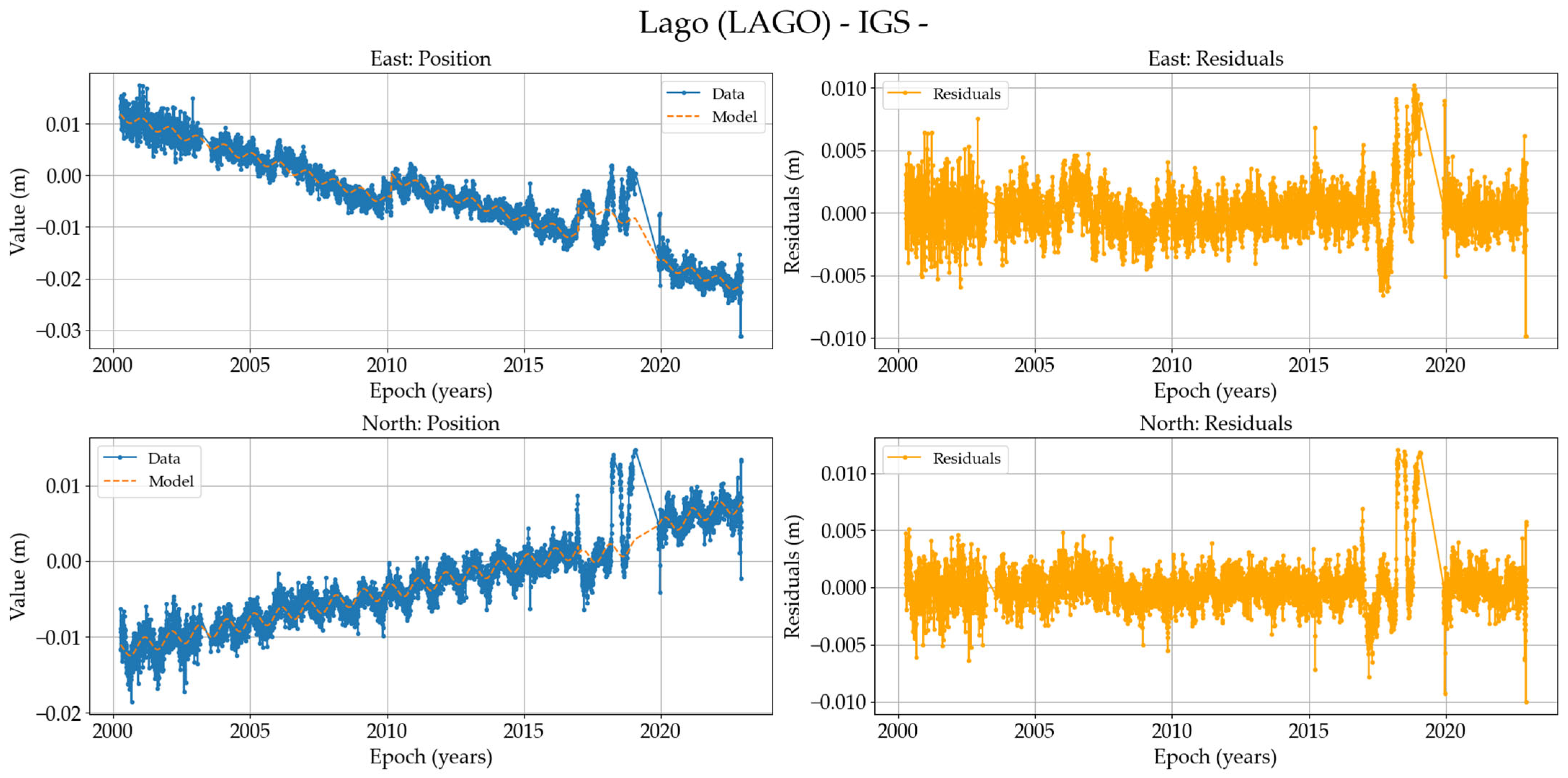
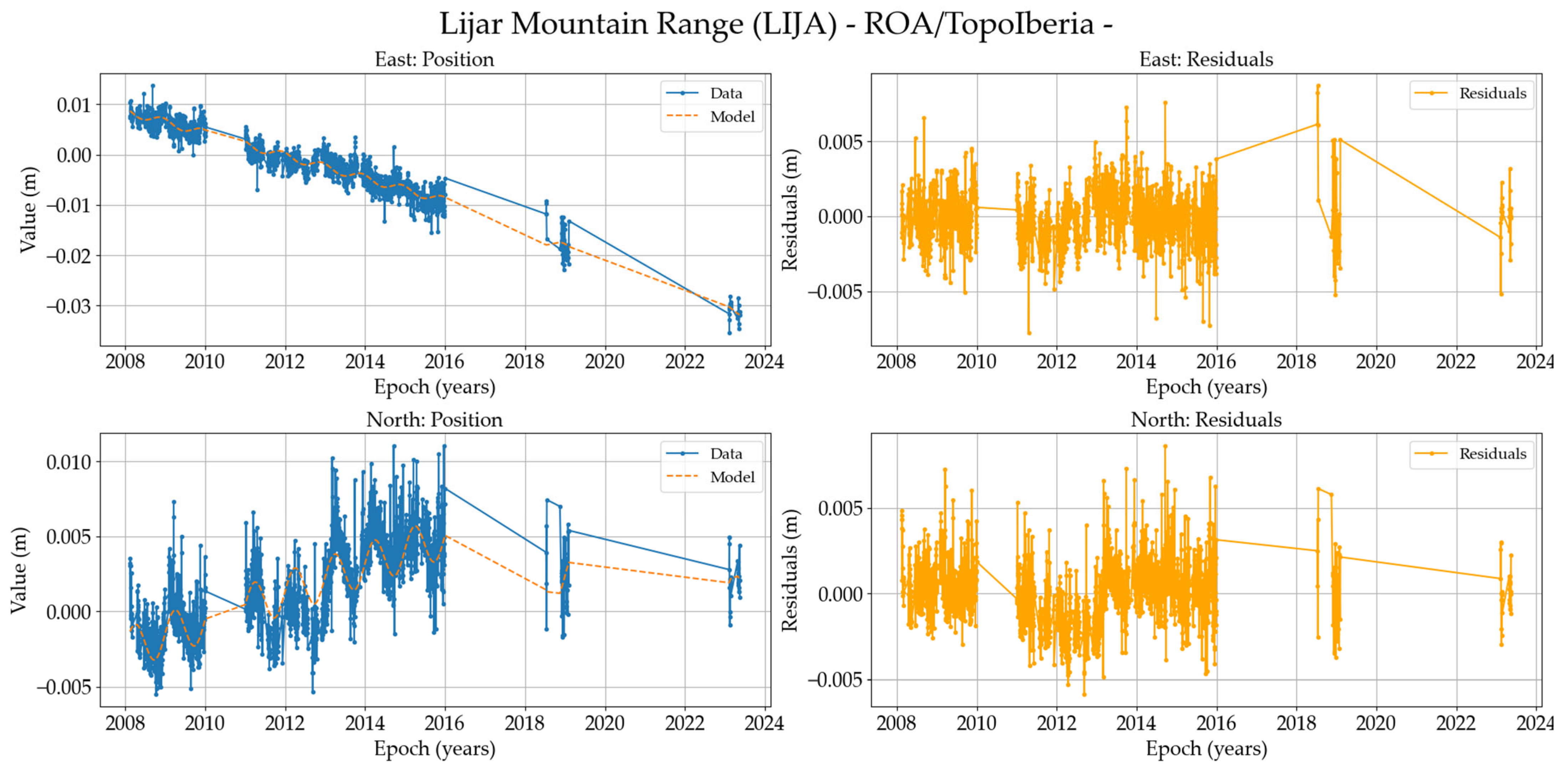
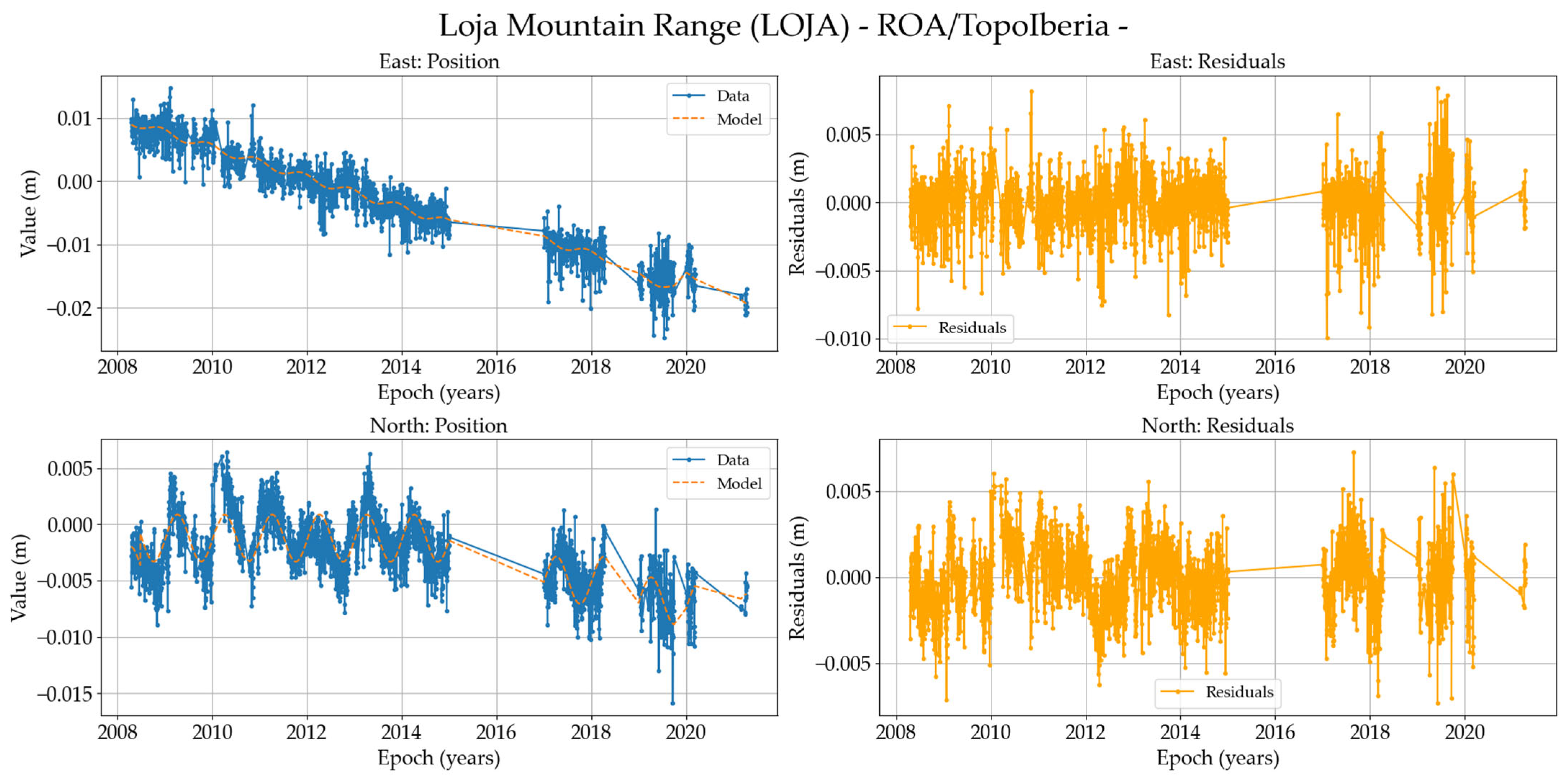

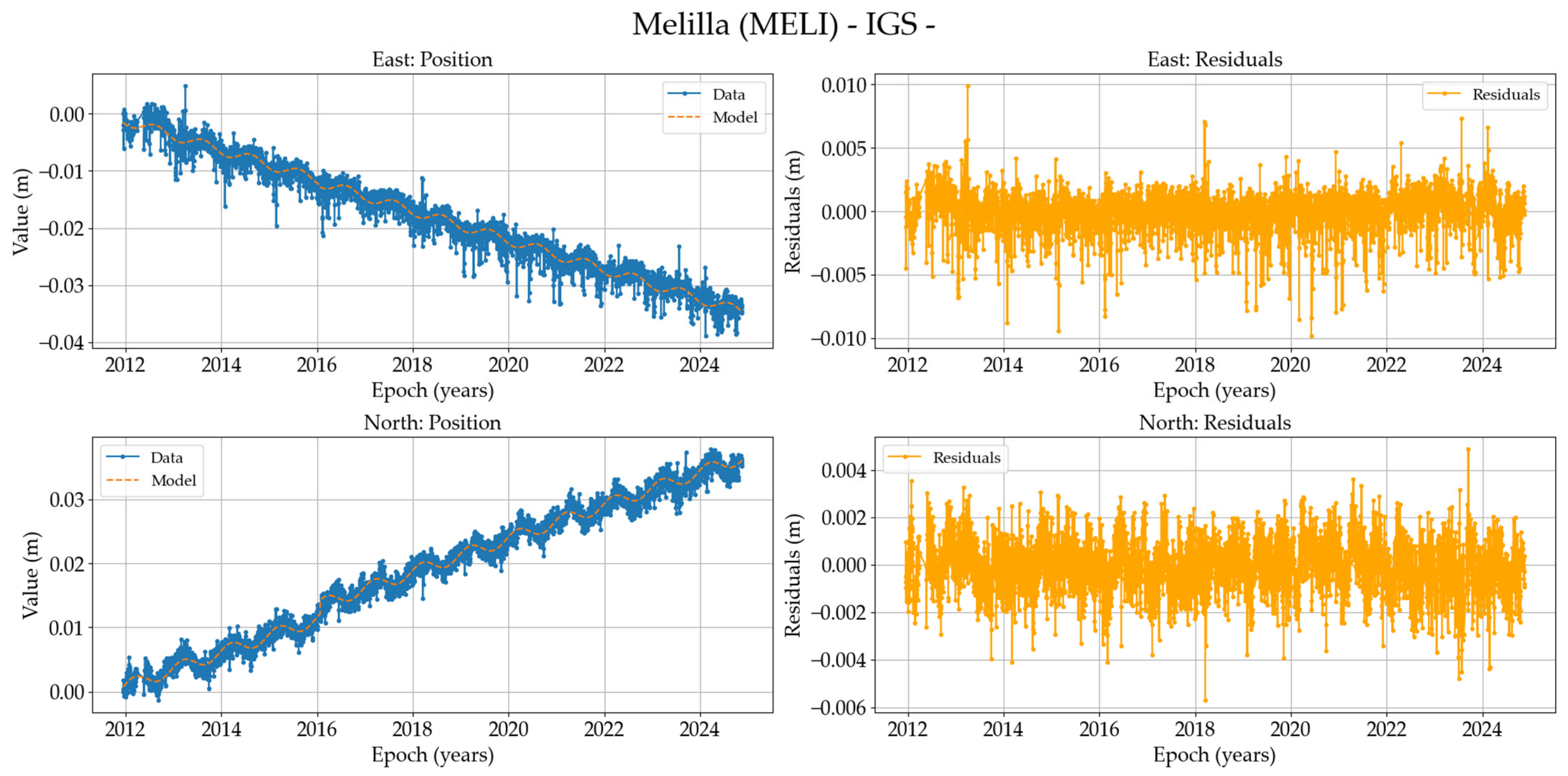

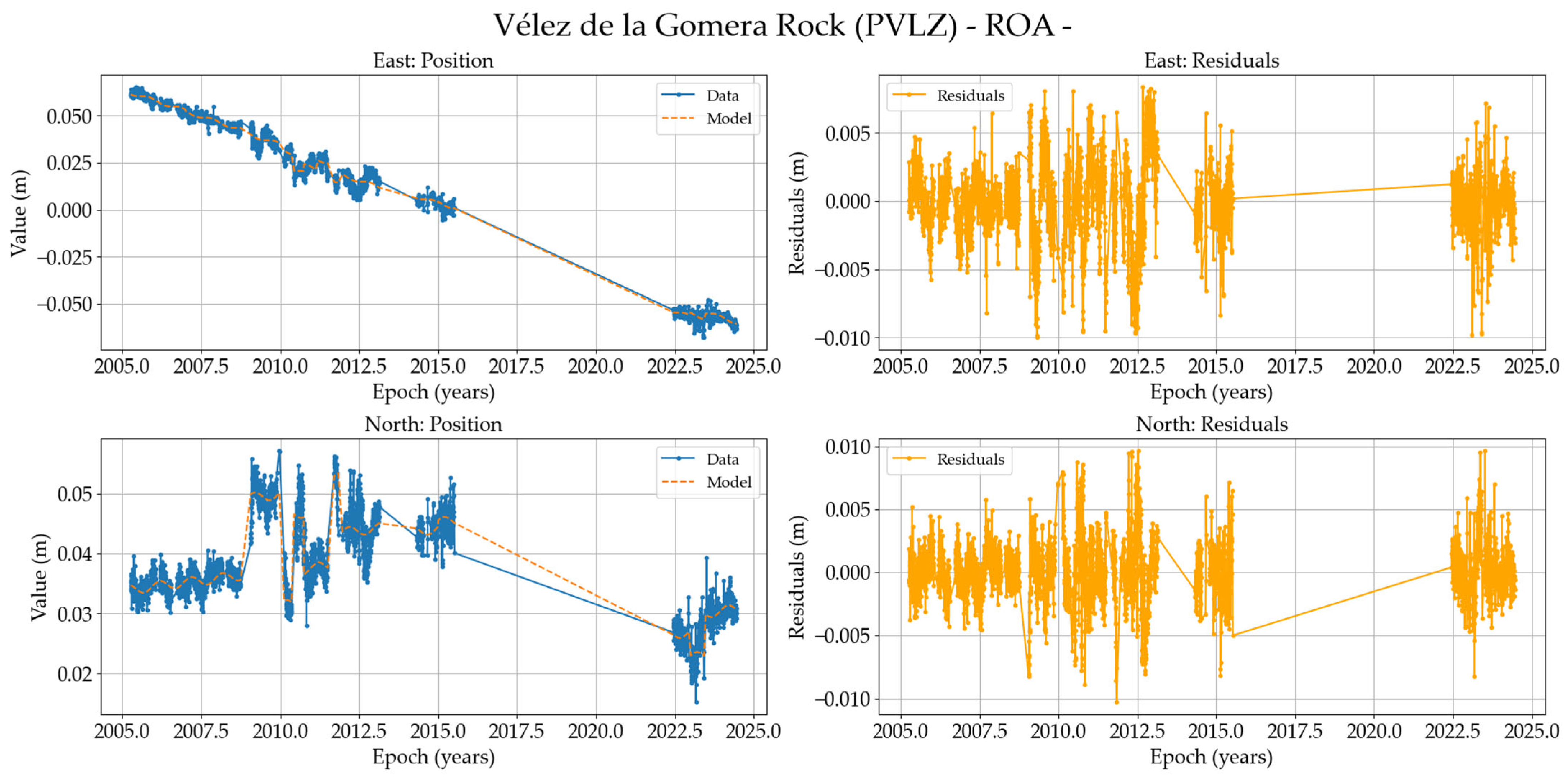
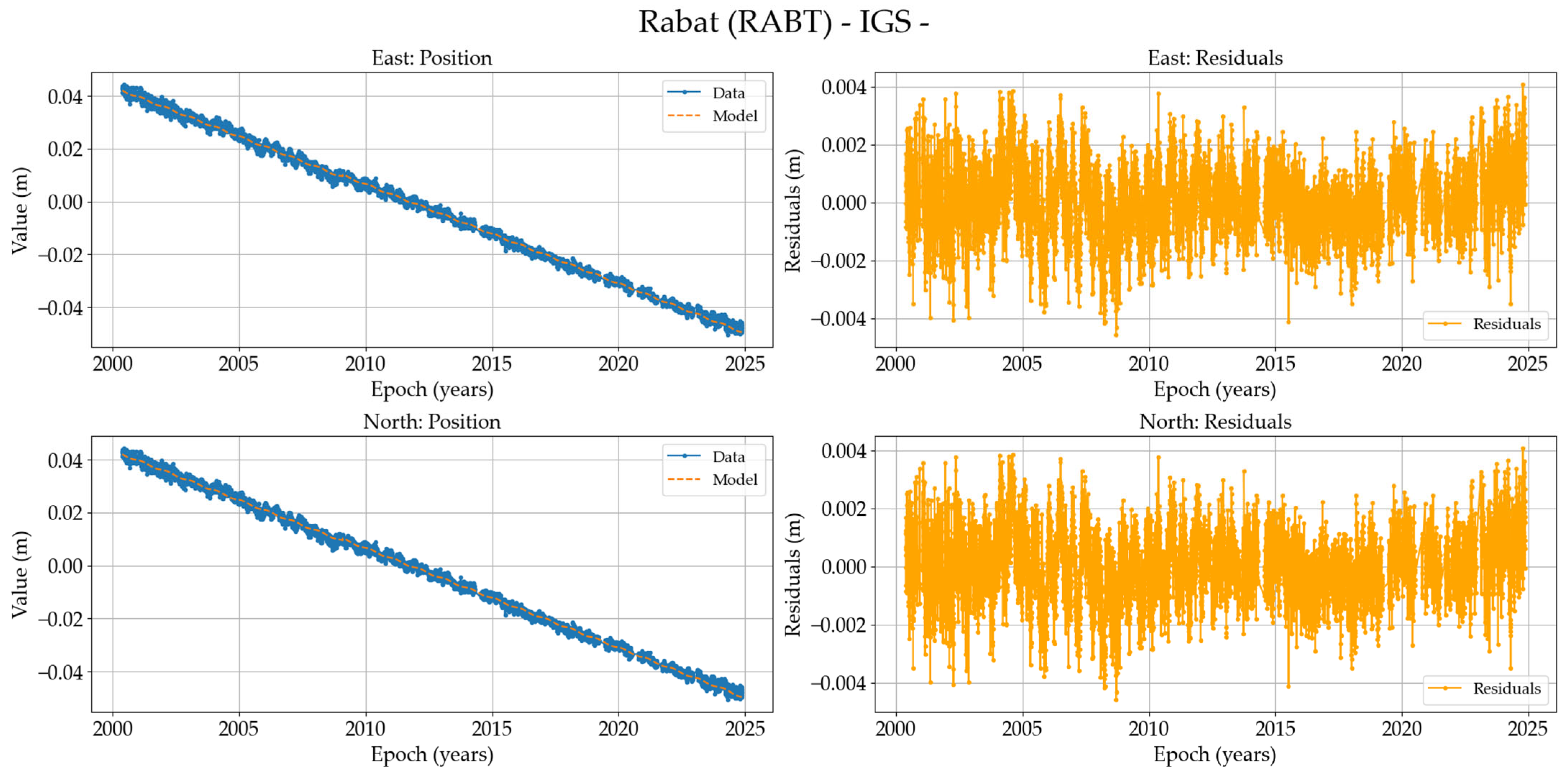

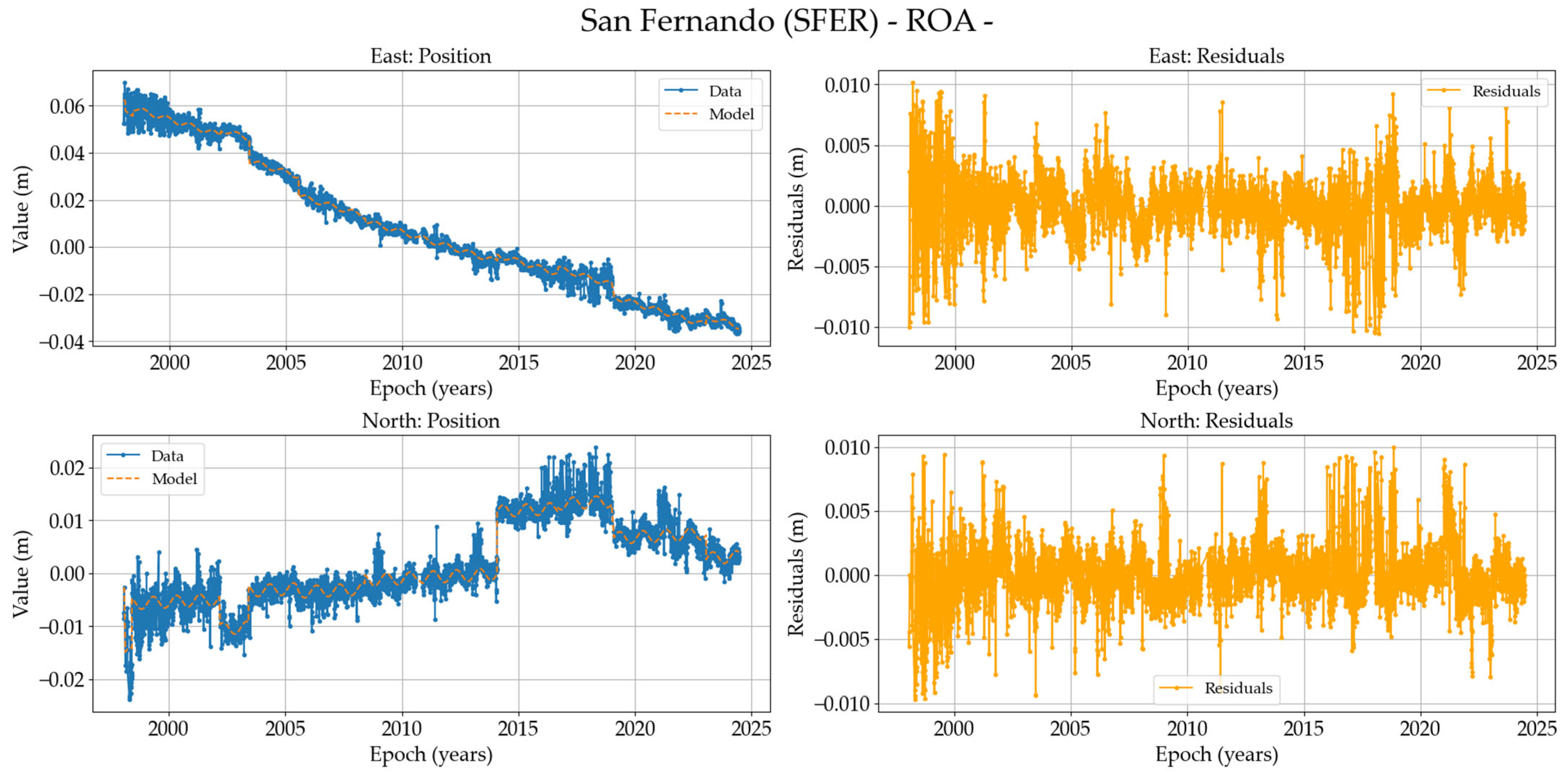

References
- Palano, M.; González, P.J.; Fernández, J. The Diffuse Plate boundary of Nubia and Iberia in the Western Mediterranean: Crustal deformation evidence for viscous coupling and fragmented lithosphere. Earth Planet. Sci. Lett. 2015, 430, 439–447. [Google Scholar] [CrossRef]
- Serpelloni, E.; Vannucci, G.; Pondrelli, S.; Argnani, A.; Casula, G.; Anzidei, M.; Baldi, P.; Gasperini, P. Kinematics of the Western Africa-Eurasia plate boundary from focal mechanisms and GPS data. Geophys. J. Int. 2007, 169, 1180–1200. [Google Scholar] [CrossRef]
- Nocquet, J.M. Present-day kinematics of the Mediterranean: A comprehensive overview of GPS results. Tectonophysics 2012, 579, 220–242. [Google Scholar] [CrossRef]
- Koulali, A.; Ouazar, D.; Tahayt, A.; King, R.W.; Vernant, P.; Reilinger, R.E.; McClusky, S.; Mourabit, T.; Davila, J.M.; Amraoui, N. New GPS constraints on active deformation along the Africa–Iberia plate boundary. Earth Planet. Sci. Lett. 2011, 308, 211–217. [Google Scholar] [CrossRef]
- Vernant, P.; Fadil, A.; Mourabit, T.; Ouazar, D.; Koulali, A.; Davila, J.M.; Garate, J.; McClusky, S.; Reilinger, R. Geodetic constraints on active tectonics of the Western Mediterranean: Implications for the kinematics and dynamics of the Nubia-Eurasia plate boundary zone. J. Geodyn. 2010, 49, 123–129. [Google Scholar] [CrossRef]
- Argus, D.F.; Gordon, R.G.; DeMets, C.; Stein, S. Closure of the Africa-Eurasia-North America plate motion circuit and tectonics of the Gloria fault. J. Geophys. Res. Solid Earth 1989, 94, 5585–5602. [Google Scholar] [CrossRef]
- DeMets, C.; Gordon, R.G.; Argus, D.F.; Stein, S. Current plate motions. Geophys. J. Int. 1990, 101, 425–478. [Google Scholar] [CrossRef]
- DeMets, C.; Gordon, R.G.; Argus, D.F.; Stein, S. Effect of recent revisions to the geomagnetic reversal time scale on estimates of current plate motions. Geophys. Res. Lett. 1994, 21, 2191–2194. [Google Scholar] [CrossRef]
- Sparacino, F.; Palano, M.; Peláez, J.A.; Fernández, J. Geodetic deformation versus seismic crustal moment-rates: Insights from the Ibero-Maghrebian region. Remote Sens. 2020, 12, 952. [Google Scholar] [CrossRef]
- Garate, J.; Martin-Davila, J.; Khazaradze, G.; Echeverria, A.; Asensio, E.; Gil, A.J.; de Lacy, M.C.; Armenteros, J.A.; Ruiz, A.M.; Gallastegui, J.; et al. Topo-Iberia project: CGPS crustal velocity field in the Iberian Peninsula and Morocco. GPS Solut. 2015, 19, 287–295. [Google Scholar] [CrossRef]
- Gallart, J. Geosciences in Iberia: Integrated studies of topography and 4-D evolution. ‘Topo-Iberia’ supported by the Spanish Government. Instituto de Ciencias de la Tierra ‘Jaume Almera’ del Consejo Superior de Investigaciones Científicas. CONSOLIDER-INGENIO 2010. 2006. Available online: https://web.igme.es/TopoIberia/default.html (accessed on 12 February 2025).
- Ryan, W.B.F.; Carbotte, S.M.; Coplan, J.O.; O’Hara, S.; Melkonian, A.; Arko, R.; Weissel, R.A.; Ferrini, V.; Goodwillie, A.; Niche, F.; et al. Global Multi-Resolution Topography synthesis. Geochem. Geophys. Geosyst. 2009, 10, Q03014. [Google Scholar] [CrossRef]
- Klitgord, K.D.; Schouten, H. Plate kinematics of the central Atlantic. In The Western North Atlantic Region; Vogt, P.R., Tucholke, B.E., Eds.; GeoScienceWorld: McLean, VA, USA, 1986; pp. 351–378. [Google Scholar] [CrossRef]
- Bird, P. An updated digital model of plate boundaries. Geochem. Geophys. Geosyst. 2003, 4, 1–52. [Google Scholar] [CrossRef]
- Gutscher, M.A. What caused the Great Lisbon earthquake? Science 2004, 305, 1247–1248. [Google Scholar] [CrossRef] [PubMed]
- Galindo-Zaldivar, J.; Gil, A.J.; Tendero-Salmerón, V.; Borque, M.J.; Ercilla, G.; González-Castillo, L.; Sánchez-Alzola, A.; Lacy, M.C.; Estrada, F.; Avilés, M.; et al. The Campo de Dalias GNSS Network Unveils the Interaction between Roll-Back and Indentation Tectonics in the Gibraltar Arc. Sensors 2022, 22, 2128. [Google Scholar] [CrossRef]
- Chalouan, A.; Gil, A.J.; Galindo-Zaldivar, J.; Ahmamou, M.; Ruano, P.; Lacy, M.C.; Ruiz-Armenteros, A.; Benmakhlouf, M.; Riguzzi, F. Active faulting in the frontal Rif Cordillera (Fes region, Morocco): Constraints from GPS data. J. Geodyn. 2014, 77, 110–122. [Google Scholar] [CrossRef]
- Fadil, A.; Vernant, P.; Mcclusky, S.; Reilinger, R.; Gomez, F.; Ben Sari, D.; Mourabit, T.; Feigl, K.L.; Barazangi, M. Active tectonics of the western Mediterranean: Geodetic evidence for rollback of a delaminated subcontinental lithospheric slab beneath the Rif Mountains, Morocco. Geology 2006, 34, 529–532. [Google Scholar] [CrossRef]
- Palano, M.; González, P.; Fernandez, J. Strain and stress fields along the Gibraltar Orogenic Arc: Constraints on active geodynamics. Gondwana Res. 2013, 23, 1071–1088. [Google Scholar] [CrossRef]
- Borque, M.J.; Sánchez-Alzola, A.; Martin-Rojas, I.; Alfaro, P.; Molina, S.; Rosa-Cintas, S.; Rodríguez-Caderot, G.; de Lacy, C.; García-Armenteros, J.A.; Avilés, M.; et al. How much Nubia-Eurasia convergence is accommodated by the NE end of the Eastern Betic Shear Zone (SE Spain) Constraints from GPS velocities. Tectonics 2019, 38, 1824–1839. [Google Scholar] [CrossRef]
- Alfaro, P.; Sánchez-Alzola, A.; Martin-Rojas, I.; García-Tortosa, F.J.; Galindo-Zaldívar, J.; Avilés, M.; López Garrido, A.C.; Sanz de Galdeano, C.; Ruano, P.; Martínez-Moreno, F.J.; et al. Geodetic fault slip rates on active faults in the Baza sub-Basin (SE Spain): Insights for seismic hazard assessment. J. Geodyn. 2021, 144, 101815. [Google Scholar] [CrossRef]
- Gil, A.J.; Borque, M.; Avilés, M.; Lacy, M.; Galindo-Zaldívar, J.; Alfaro, P.; García-Tortosa, F.J.; Sanchez-Alzola, A.; Martin-Rojas, I.; Medina-Cascales, I.; et al. Crustal velocity field in Baza and Galera faults: A new estimation from GPS position time series in 2009–2018-time span. In Proceedings of the 5th Joint International Symposium on Deformation Monitoring (JISDM), Valencia, Spain, 20–22 June 2022. [Google Scholar] [CrossRef]
- Gonzalez-Castillo, L.; Galindo-Zaldivar, J.; de Lacy, M.C.; Borque, M.J.; Martínez-Moreno, F.J.; García-Armenteros, J.A.; Gil, A.J. Active rollback in the Gibraltar Arc: Evidences from CGPS data in the western Betic Cordillera. Tectonophysics 2015, 663, 310–321. [Google Scholar] [CrossRef]
- Galindo-Zaldivar, J.; Azzouz, O.; Chalouan, A.; Pedrera, A.; Ruano, P.; Ruiz-Constán, A.; Sanz de Galdeano, C.; Marín-Lechado, C.; López-Garrido, A.; Anahnah, F.; et al. Extensional tectonics, graben development and fault terminations in the eastern Rif (Bokoya-Ras Afraou area). Tectonophysics 2015, 663, 140–149. [Google Scholar] [CrossRef]
- Chalouan, A.; Gil, A.J.; Chabli, A.; Bargach, K.; Liemlahi, H.; El Kadiri, K.; Tendero-Salmerón, V.; Galindo-Zaldívar, J. cGPS Record of Active Extension in Moroccan Meseta and Shortening in Atlasic Chains under the Eurasia-Nubia Convergence. Sensors 2023, 23, 4846. [Google Scholar] [CrossRef]
- Moussaid, B.; Hmidou, E.; Casas-Sainz, A.; Pocoví, A.; Román-Berdiel, T.; Oliva-Urcia, B.; Ruiz-Martínez, V.C.; Villalaín, J. The Geological Setting of the Moroccan High Atlas and Its Plate Tectonics Context. In Tectonic Evolution of the Moroccan High Atlas: A Paleomagnetic Perspective; Calvín, P., Casas-Sainz, A.M., Román-Berdiel, T., Villalaín, J.J., Eds.; Springer Geology; Springer: Cham, Switzerland, 2023. [Google Scholar] [CrossRef]
- Gallastegui, J.; Pulgar, J.; González-Cortina, J.; Garate, J.; Martín-Dávila, J.; Khazaradze, G.; Gil, A.J.; Ruiz-Armenteros, A.M.; Jiménez-Munt, I.; Ayala, C.; et al. Despliegue de estaciones GPS permanentes en el marco del proyecto Topo-Iberia. In Proceedings of the Conference: VII Congreso Geológico de España, Las Palmas de Gran Canarias, Spain, 14–18 July 2008; Geo-Temas: Salamanca, Spain, 2008. [Google Scholar]
- Geng, J.; Chen, X.; Pan, Y.; Mao, S.; Li, C.; Zhou, J.; Zhang, K. PRIDE PPP-AR: An open-source software for GPS PPP ambiguity resolution. GPS Solut. 2019, 23, 91. [Google Scholar] [CrossRef]
- Teunissen, P.; Montenbruck, O. Precise Point Positioning: A Powerful Technique with Applications in GPS, GLONASS, Galileo, and BeiDou Navigation Systems. GPS Solut. 2017, 21, 1–12. [Google Scholar] [CrossRef]
- Dach, R.; Selmke, I.; Villiger, A.; Arnold, D.; Prange, L.; Schaer, S.; Sidorov, D.; Stebler, P.; Jäggi, A.; Hugentobler, U. Review of recent GNSS modelling improvements based on CODEs Repro3 contribution. Adv. Space Res. 2021, 68, 1263–1280. [Google Scholar] [CrossRef]
- Altamimi, Z.; Rebischung, P.; Collilieux, X.; Métivier, L.; Chanard, K. ITRF2020: An augmented reference frame refining the modeling of nonlinear station motions. J. Geod. 2023, 97, 47. [Google Scholar] [CrossRef]
- Saastamoinen, J. Atmospheric correction for the troposphere and stratosphere in radio ranging satellites. Geophys. Monogr. Ser. 1972, 15, 247–251. [Google Scholar] [CrossRef]
- Boehm, J.; Werl, B.; Schuh, H. Troposphere mapping functions for GPS and very long baseline interferometry from European Centre for Medium-Range Weather Forecasts operational analysis data. J. Geophys. Res. 2006, 111, B02406. [Google Scholar] [CrossRef]
- Bos, M.S.; Scherneck, H.G. Ocean Tide Loading. 2024. Available online: http://holt.oso.chalmers.se/loading/ (accessed on 5 June 2024).
- Lyard, F.H.; Allain, D.J.; Cancet, M.; Carrère, L.; Picot, N. FES2014 global ocean tide atlas: Design and performance. Ocean Sci. 2021, 17, 615–649. [Google Scholar] [CrossRef]
- Teunissen, P.; Jonge, P.; Tiberius, C. The least-squares ambiguity decorrelation adjustment: Its performance on short GPS baselines and short observation spans. J. Geod. 1997, 71, 589–602. [Google Scholar] [CrossRef]
- Santamaría-Gómez, A. SARI: Interactive GNSS position time series analysis software. GPS Solut. 2019, 23, 52. [Google Scholar] [CrossRef]
- Bruyninx, C.; Legrand, J.; Fabian, A.; Pottiaux, E. GNSS Metadata and Data Validation in the EUREF Permanent Network. GPS Solut. 2019, 23, 106. [Google Scholar] [CrossRef]
- Johnston, G.; Riddell, A.; Hausler, G. The International GNSS Service. In Springer Handbook of Global Navigation Satellite Systems, 1st ed.; Teunissen, P.J.G., Montenbruck, O., Eds.; Springer International Publishing: Cham, Switzerland, 2017; pp. 967–982. [Google Scholar] [CrossRef]
- Fernandes, R.; Bruyninx, C.; Crocker, P.; Menut, J.; Socquet, A.; Vergnolle, M.; Avallone, A.; Bos, M.; Bruni, S.; Cardoso, R.; et al. A new European service to share GNSS Data and Products. Ann. Geophys. 2022, 65, DM317. [Google Scholar] [CrossRef]
- Altamimi, Z.; Métivier, L.; Rebischung, P.; Collilieux, X.; Chanard, K.; Barnéoud, J. ITRF2020 plate motion model. Geophys. Res. Lett. 2023, 50, e2023GL106373. [Google Scholar] [CrossRef]
- Strutz, T. Data Fitting and Uncertainty (A Practical Introduction to Weighted Least Squares and Beyond), 2nd ed.; Springer: Berlin/Heidelberg, Germany, 2016; ISBN 978-3-658-11455-8. [Google Scholar]
- Blewitt, G.; Kreemer, C.; Hammond, W.C.; Gazeaux, J. MIDAS robust trend estimator for accurate GPS station velocities without step detection. J. Geophys. Res. Solid Earth 2016, 121, 2054–2068. [Google Scholar] [CrossRef]
- Huang, J.; He, X.; Hu, S.; Ming, F. Impact of Offsets on GNSS Time Series Stochastic Noise Properties and Velocity Estimation. Adv. Space Res. 2024, in press. [CrossRef]
- Wang, L.; Herring, T. Impact of estimating position offsets on the uncertainties of GNSS site velocity estimates. J. Geophys. Res. Solid Earth 2019, 124, 13452–13467. [Google Scholar] [CrossRef]
- Van Rossum, G.; Drake, F.L. Python 3 Reference Manual; CreateSpace: Scotts Valley, CA, USA, 2009. [Google Scholar]
- Wessel, P.; Luis, J.F.; Uieda, L.; Scharroo, R.; Wobbe, F.; Smith, W.H.F.; Tian, D. The Generic Mapping Tools version 6. Geochem. Geophys. Geosystems 2019, 20, 5556–5564. [Google Scholar] [CrossRef]
- Geng, J.; Mao, S. Massive GNSS network analysis without baselines: Undifferenced ambiguity resolution. J. Geophys. Res. Solid Earth 2021, 126, e2020JB021558. [Google Scholar] [CrossRef]
- Shen, Z.; Wang, M.; Zeng, Y.; Wang, F. Optimal Interpolation of Spatially Discretized Geodetic Data. Bull. Seismol. Soc. Am. 2015, 105, 2117–2127. [Google Scholar] [CrossRef]
- Instituto Geográfico Nacional (IGN). Catálogo de Terremotos. Available online: https://www.ign.es/web/sis-catalogo-terremotos?utm_source=chatgpt.com (accessed on 12 February 2025).
- Altamimi, Z.; Collilieux, X.; Metivier, L. ITRF2008: An improved solution of the international terrestrial reference frame. J. Geod. 2011, 85, 457–473. [Google Scholar] [CrossRef]
- Altamimi, Z.; Collilieux, X.; Legrand, J.; Garayt, B.; Boucher, C. ITRF2005: A new release of the international terrestrial reference frame based on time series of station positions and earth orientation parameters. J. Geophys. Res. 2007, 112, B09401. [Google Scholar] [CrossRef]
- Fernandes, R.M.S.; Miranda, J.M.; Meijninger, B.M.L.; Bos, M.S.; Noomen, R.; Bastos, L.; Ambrosius, B.A.C.; Riva, R.E.M. Surface velocity field of the Ibero–Maghrebian segment of the Eurasia–Nubia plate boundary. Geophys. J. Int. 2007, 169, 315–324. [Google Scholar] [CrossRef]
- Martin-Rojas, I.; Alfaro, P.; Galindo-Zaldivar, J.; Borque-Arancón, M.J.; García-Tortosa, F.J.; Sanz de Galdeano, C.; Avilés, M.; Sánchez-Alzola, A.; González-Castillo, L.; Ruano, P.; et al. Insights of active extension within a collisional orogen from GNSS (Central Betic Cordillera, S Spain). Tectonics 2023, 42, e2022TC007723. [Google Scholar] [CrossRef]
- Grützner, C.; Reicherter, K.; Hübscher, C.; Silva, P.G. Active faulting and neotectonics in the Baelo Claudia area, Campo de Gibraltar (southern Spain). Tectonophysics 2012, 554–557, 127–142. [Google Scholar] [CrossRef]
- Luján, M.; Crespo-Blanc, A.; Comas, M. Morphology and structure of the Camarinal Sill from high-resolution bathymetry: Evidence of fault zones in the Gibraltar Strait. Geo-Mar. Lett. 2011, 31, 163–174. [Google Scholar] [CrossRef]
- Lafosse, M.; d’Acremont, E.; Rabaute, A.; Lépinay, B.; Tahayt, A.; Ammar, A.; Gorini, C. Evidence of Quaternary transtensional tectonics in the Nekor basin (NE Morocco). Basin Res. 2016, 29, 470–489. [Google Scholar] [CrossRef]
- Galindo-Zaldivar, J.; Ercilla, G.; Estrada, F.; Catalán, M.; d’Acremont, E.; Azzouz, O.; Casas, D.; Chourak, M.; Vazquez, J.T.; Chalouan, A.; et al. Imaging the growth of recent faults: The case of 2016–2017 seismic sequence sea bottom deformation in the Alboran Sea (western Mediterranean). Tectonics 2018, 37, 2513–2530. [Google Scholar] [CrossRef]
- Perouse, E.; Vernant, P.; Chery, J.; Reilinger, R.; McClusky, S. Active surface deformation and sub-lithospheric processes in the western Mediterranean constrained by numerical models. Geology 2010, 38, 823–826. [Google Scholar] [CrossRef]
- Civiero, C.; Custódio, S.; Duarte, J.C.; Mendes, V.B.; Faccenna, C. Dynamics of the Gibraltar arc system: A complex interaction between plate convergence, slab pull, and mantle flow. J. Geophys. Res. Solid Earth 2020, 125, e2019JB018873. [Google Scholar] [CrossRef]



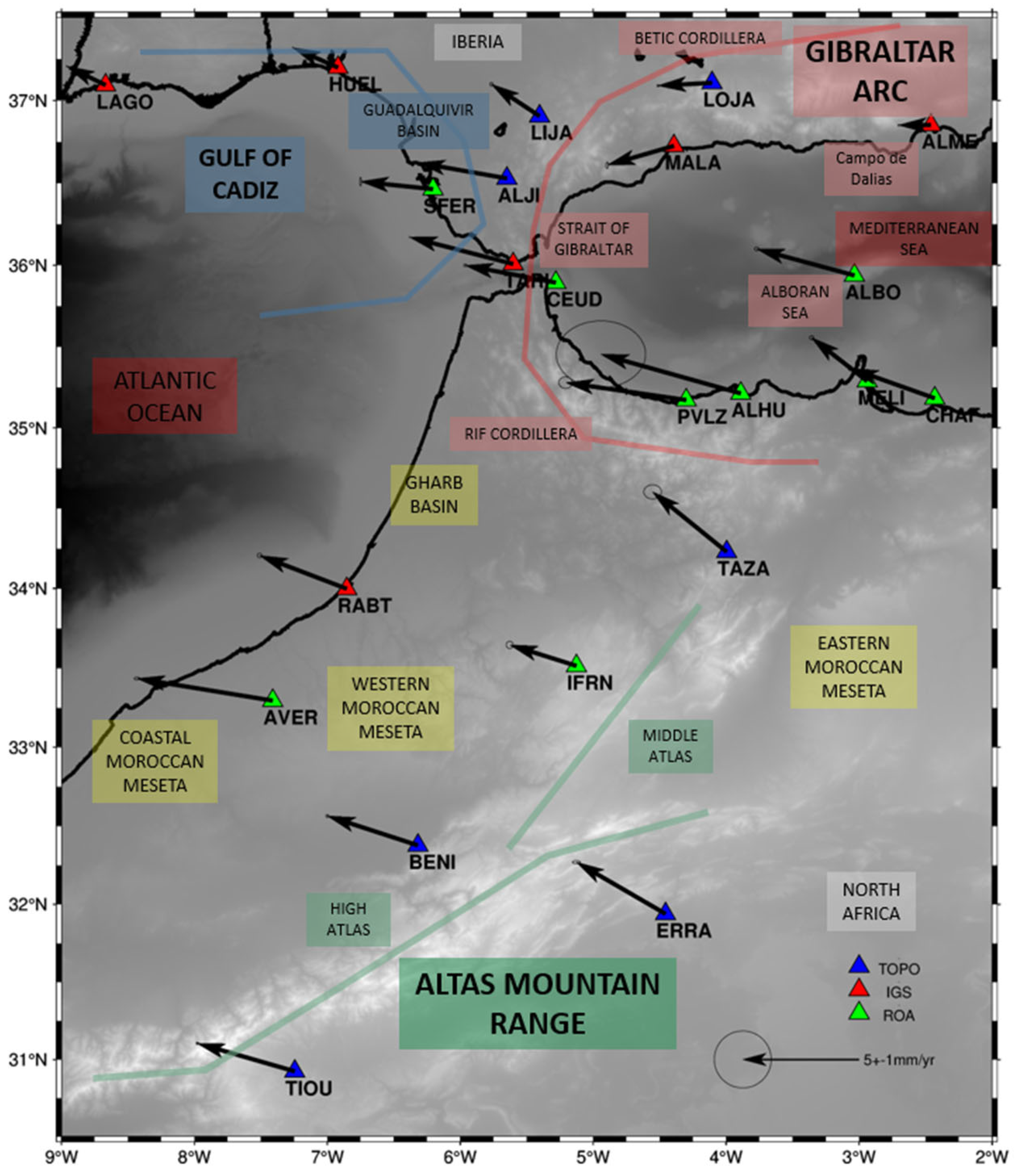
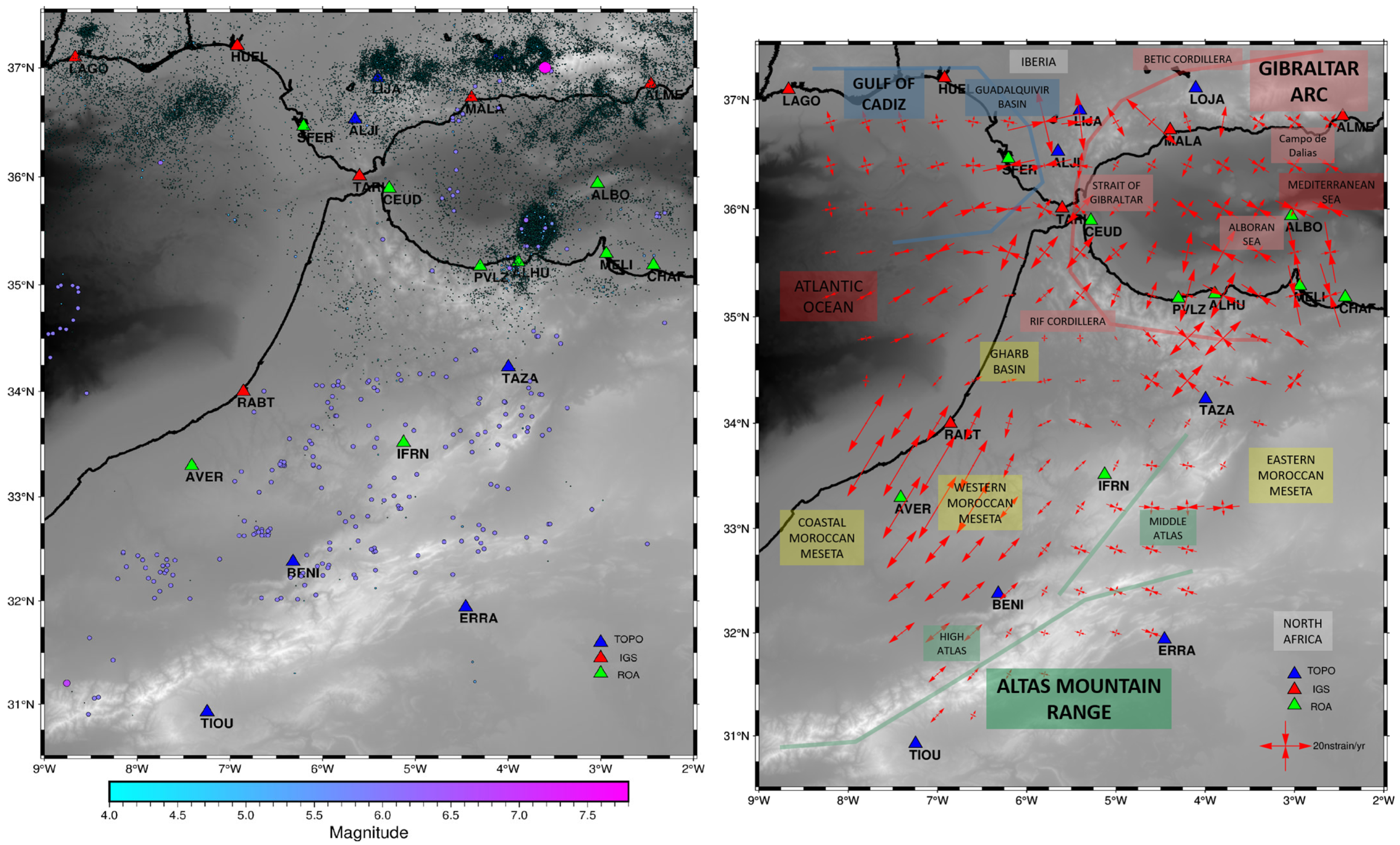
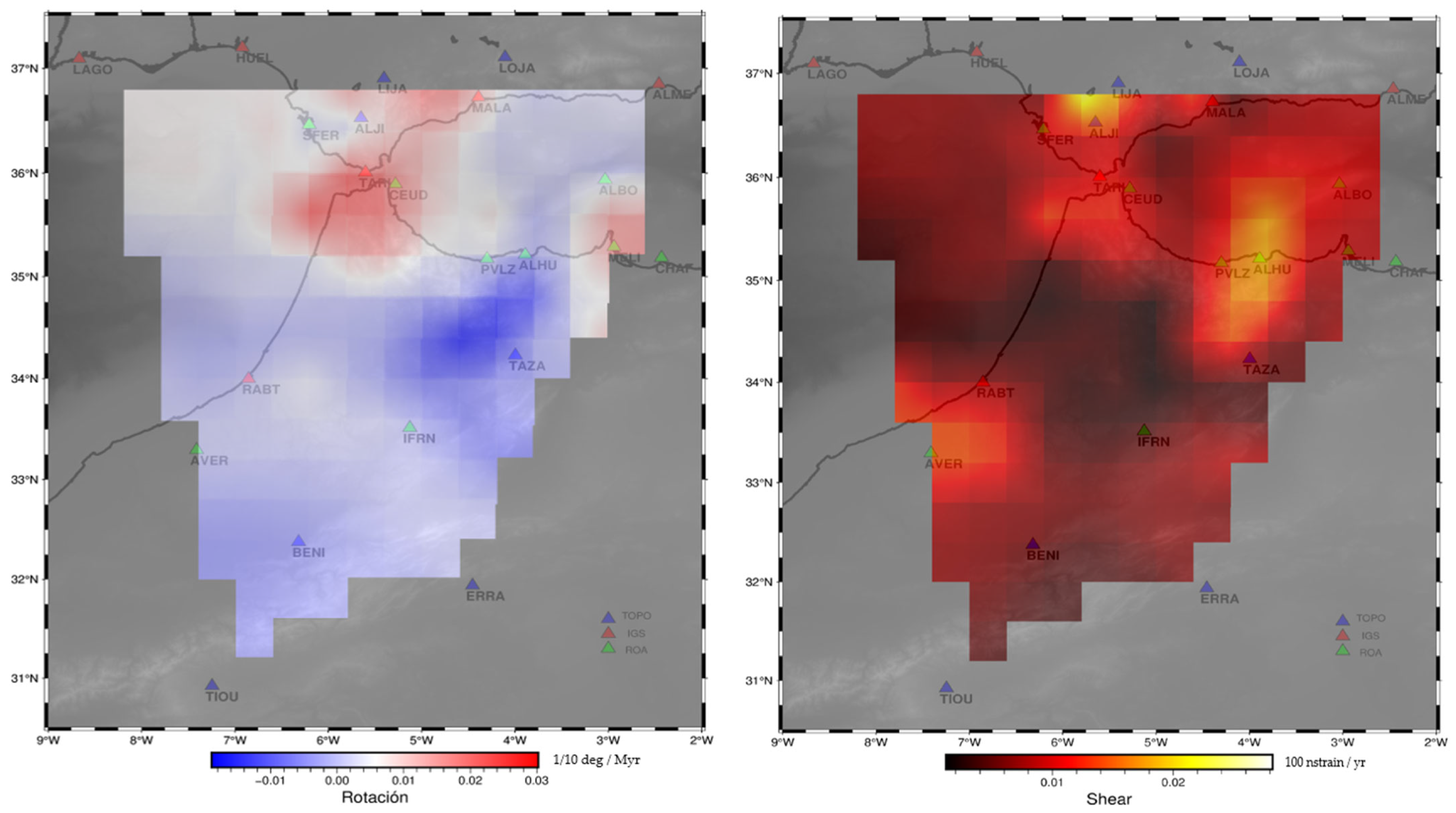
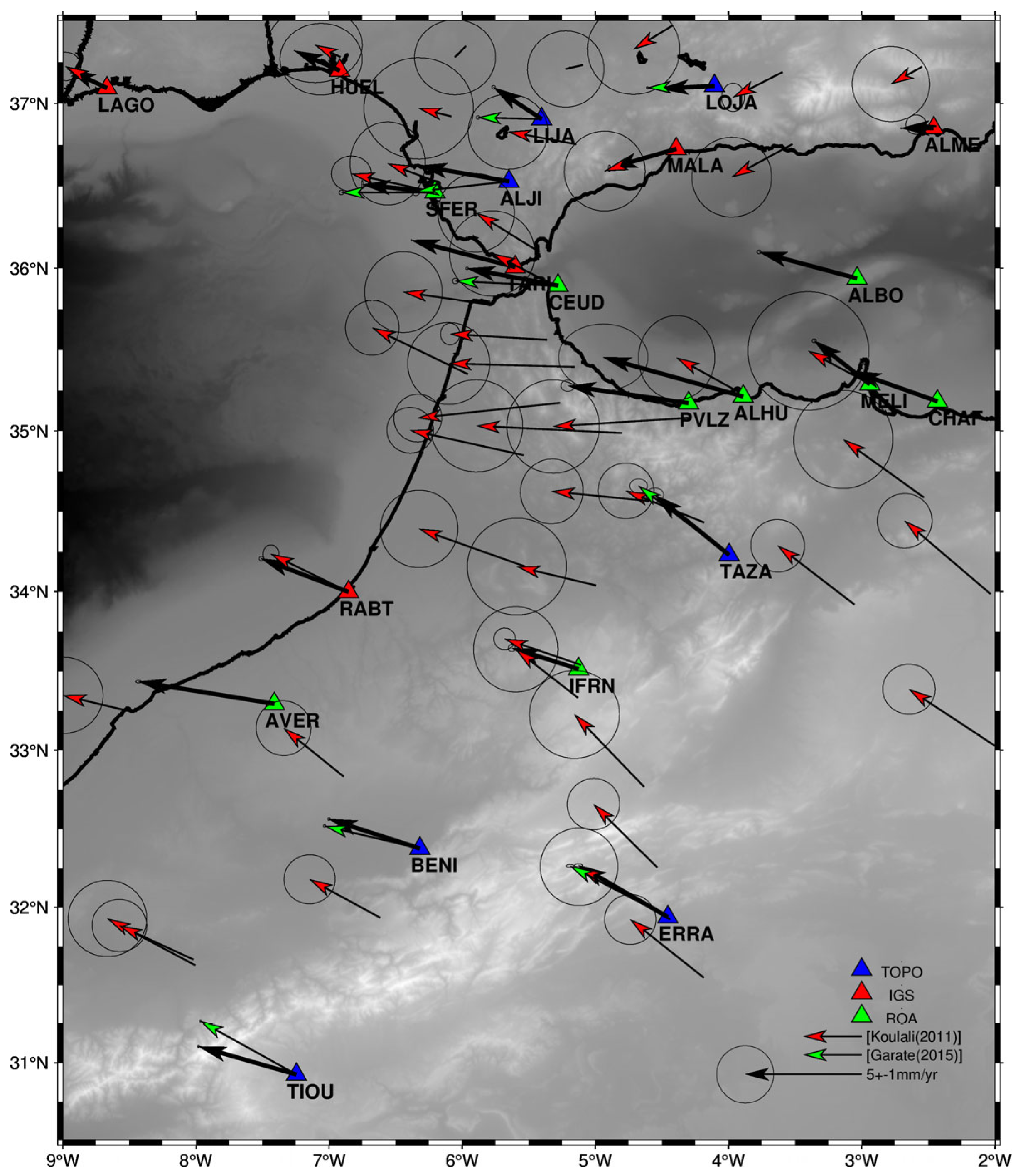
| Station | Location | Power Supply | Equipment (Receiver/Antenna) | Agency | Period (y/m/d) | |
|---|---|---|---|---|---|---|
| Start | Last Data | |||||
| ALBO | Alboral Island | Power generator | Trimble NETRS/TRM29659 | ROA | 2009/01/29 | 2023/03/22 |
| ALBO | Alboral Island | Power generator | TRIMBLE NETR9/TRM57971.00 | IGN | 2015/11/21 | 2024/06/16 |
| ALHU | Alhucemas Rock | Power generator | LEICA GR25/LEIAR25 | ROA | 2022/06/19 | 2024/06/16 |
| ALJI | Aljibe Mountain Range | Solar power supply | Trimble NETRS/TRM29659 | Topo-Iberia/ROA | 2008/04/10 | 2023/12/31 |
| ALME | Almería | Electric current | TRIMBLE NETR9/TRM29659 | IGS | 2001/01/01 | 2024/06/16 |
| AVER | Averroes laboratory | Electric current | Trimble NETRS/TRM29659 | ROA/ISRABAT | 2010/12/20 | 2024/06/16 |
| BENI | Beni Melal | Electric current | Trimble NETRS/TRM29659 | Topo-Iberia/ROA | 2008/09/16 | 2014/02/12 |
| CEUD | Ceuta Desnarigado | Electric current | Trimble NETRS/TRM29659 | ROA | 2004/01/15 | 2024/06/16 |
| CHAF | Isabel II Island | Power generator | Trimble NETRS/TRM29659 | ROA | 2007/10/06 | 2024/04/20 |
| ERRA | Errachidia | Electric current | Trimble NETRS/TRM29659 | Topo-Iberia/ROA | 2008/09/16 | 2014/02/12 |
| HUEL | Huelva | Electric current | TRIMBLE ALLOY/TRM159900 | IGS | 2003/03/11 | 2024/06/16 |
| IFRN | Ifrane laboratory | Electric current | Trimble NETRS/TRM29659 | ROA/ISRABAT | 2018/08/26 | 2022/03/10 |
| LAGO | Lago | Electric current | TRIMBLE ALLOY/TRM159900 | IGS | 2000/03/06 | 2024/06/16 |
| LIJA | Lijar Mountain Range | Solar power supply | Trimble NETRS/TRM29659 | Topo-Iberia/ROA | 2008/02/12 | 2023/05/16 |
| LOJA | Loja Mountain Range | Solar power supply | Trimble NETRS/TRM29659 | Topo-Iberia/ROA | 2008/04/17 | 2021/04/13 |
| MALA | Málaga | Electric current | LEICA GR25/LEIAR25.R4 | IGS | 2003/01/01 | 2024/06/16 |
| MELI | Melilla | Electric current | Trimble NETRS/TRM29659 | ROA | 2000/01/04 | 2014/12/09 |
| MELI | Melilla | Electric current | LEICA GR50/LEIAR25.R4 | IGS | 2011/12/14 | 2024/06/16 |
| PVLZ | Vélez Rock | Power generator | LEICA GR25/LEIAR20 | ROA | 2005/04/07 | 2024/06/16 |
| RABT | Rabat | Electric current | JAVAD TRE_3 DELTA/TRM29659 | IGS | 2000/04/16 | 2024/06/16 |
| ROTA | Rota Naval Base | Electric current | Trimble NETRS/TRM29659 | ROA | 2010/04/07 | 2024/06/16 |
| SFER | San Fernando ROA | Electric current | LEICA GR30/LEIAR25 | ROA/IGS | 1995/12/18 | 2024/06/16 |
| TARI | Tarifa | Electric current | LEICA GR25/LEIAR20 | IGS | 2010/04/10 | 2022/11/10 |
| TAZA | Taza | Electric current | Trimble NETRS/TRM29659 | Topo-Iberia/ROA | 2008/07/23 | 2014/02/12 |
| TIOU | Tiouine laboratory | Electric current | Trimble NETRS/TRM29659 | Topo-Iberia/ROA/ISRABAT | 2008/09/16 | 2024/06/16 |
| Station | Total Vel (mm/year) | SD (mm/year) | EURA Vel (mm/year) | SD (mm/year) | ||||
|---|---|---|---|---|---|---|---|---|
| East | North | East | North | East | North | East | North | |
| SFER PRIDE | 16.55 | 16.98 | ±0.01 | ±0.01 | −3.12 | 0.32 | ±0.01 | ±0.01 |
| SFER IGS | 16.37 | 17.02 | ±0.02 | ±0.02 | −3.28 | 0.39 | ±0.02 | ±0.02 |
| Station | IGb20 Vel (mm/year) | SD (mm/year) | EURA Vel (mm/year) | SD (mm/year) | ||||||||
|---|---|---|---|---|---|---|---|---|---|---|---|---|
| East | North | East | North | |||||||||
| East | North | East | North | LS | MIDAS | LS | MIDAS | LS | MIDAS | LS | MIDAS | |
| ALBO ROA | 16.14 | 17.69 | ±0.03 | ±0.03 | −4.20 | −4.33 | 1.14 | 1.12 | ±0.04 | ±0.17 | ±0.03 | ±0.13 |
| ALBO IGN | 18.09 | 17.80 | ±0.03 | ±0.03 | −2.43 | −2.40 | 1.34 | 1.25 | ±0.03 | ±0.21 | ±0.03 | ±0.16 |
| ALHU | 14.69 | 15.22 | ±0.20 | ±0.20 | −6.01 | - | 1.68 | - | ±0.787 | - | ±0.58 | - |
| ALJI | 16.19 | 17.67 | ±0.03 | ±0.03 | −3.86 | −4.45 | 0.68 | 0.71 | ±0.03 | ±0.55 | ±0.01 | ±0.31 |
| ALME | 18.81 | 16.64 | ±0.02 | ±0.02 | −1.39 | −1.25 | −0.01 | −0.01 | ±0.02 | ±0.02 | ±0.01 | ±0.01 |
| AVER | 14.71 | 16.57 | ±0.08 | ±0.08 | −5.83 | −5.59 | −0.95 | −1.31 | ±0.05 | ±0.41 | ±0.02 | ±0.19 |
| BENI | 16.62 | 17.94 | ±0.02 | ±0.02 | −3.89 | −3.96 | 1.27 | 1.09 | ±0.02 | ±0.15 | ±0.02 | ±0.17 |
| CEUD | 15.83 | 16.94 | ±0.01 | ±0.01 | −3.90 | −4.17 | 0.74 | 0.51 | ±0.02 | ±0.26 | ±0.02 | ±0.17 |
| CHAF | 16.91 | 18.02 | ±0.09 | ±0.09 | −3.63 | −3.82 | 1.49 | 1.79 | ±0.03 | ±0.14 | ±0.04 | ±0.18 |
| ERRA | 15.76 | 18.91 | ±0.01 | ±0.01 | −3.83 | −4.01 | 2.22 | 2.13 | ±0.01 | ±0.15 | ±0.01 | ±0.16 |
| HUEL | 17.55 | 17.51 | ±0.02 | ±0.02 | −1.94 | −1.90 | 0.90 | 0.89 | ±0.01 | ±0.01 | ±0.01 | ±0.01 |
| IFRN | 17.60 | 17.54 | ±0.06 | ±0.06 | −2.87 | −2.73 | 0.94 | 1.18 | ±0.06 | ±0.22 | ±0.06 | ±0.20 |
| LAGO | 17.42 | 17.41 | ±0.01 | ±0.01 | −1.67 | −1.60 | 0.81 | 0.79 | ±0.01 | ±0.01 | ±0.01 | ±0.01 |
| LIJA | 17.62 | 17.97 | ±0.02 | ±0.02 | −2.07 | −2.26 | 1.37 | 0.92 | ±0.03 | ±0.19 | ±0.03 | ±0.21 |
| LOJA | 17.53 | 16.43 | ±0.01 | ±0.02 | −2.32 | −2.29 | −0.13 | −0.22 | ±0.02 | ±0.14 | ±0.01 | ±0.19 |
| MALA | 17.13 | 1.94 | ±0.01 | ±0.01 | −2.87 | −2.78 | −0.83 | −0.80 | ±0.01 | ±0.01 | ±0.01 | ±0.01 |
| MELI ROA | 18.04 | 18.41 | ±0.03 | ±0.03 | −2.39 | −2.91 | 1.86 | 2.04 | ±0.04 | ±0.18 | ±0.03 | ±0.15 |
| MELI IGN | 17.46 | 18.76 | ±0.01 | ±0.01 | −2.89 | −2.93 | 1.65 | 1.86 | ±0.01 | ±0.01 | ±0.01 | ±0.01 |
| PVLZ | 15.06 | 17.34 | ±0.10 | ±0.10 | −5.19 | −5.70 | 0.75 | 0.98 | ±0.11 | ±0.22 | ±0.10 | ±0.23 |
| RABT | 16.38 | 18.04 | ±0.01 | ±0.01 | −3.75 | −3.68 | 1.43 | 1.40 | ±0.01 | ±0.01 | ±0.01 | ±0.01 |
| ROTA | 18.27 | 19.64 | ±0.34 | ±0.34 | −2.38 | −1.85 | 2.22 | −1.60 | ±0.04 | ±0.60 | ±0.04 | ±0.22 |
| SFER | 16.55 | 16.98 | ±0.01 | ±0.01 | −3.12 | −3.29 | 0.32 | 0.43 | ±0.01 | ±0.07 | ±0.01 | 0.06 |
| TARI | 15.83 | 18.04 | ±0.01 | ±0.01 | −4.46 | −4.32 | 1.16 | 1.10 | ±0.001 | ±0.01 | ±0.01 | ±0.01 |
| TAZA | 17.31 | 19.17 | ±0.11 | ±0.10 | −3.18 | −2.91 | 2.58 | 1.88 | ±0.02 | ±0.39 | ±0.01 | 0.36 |
| TIOU | 16.48 | 17.93 | ±0.14 | ±0.14 | −4.20 | −4.27 | 1.21 | 1.13 | ±0.01 | ±0.09 | ±0.01 | ±0.11 |
Disclaimer/Publisher’s Note: The statements, opinions and data contained in all publications are solely those of the individual author(s) and contributor(s) and not of MDPI and/or the editor(s). MDPI and/or the editor(s) disclaim responsibility for any injury to people or property resulting from any ideas, methods, instructions or products referred to in the content. |
© 2025 by the authors. Licensee MDPI, Basel, Switzerland. This article is an open access article distributed under the terms and conditions of the Creative Commons Attribution (CC BY) license (https://creativecommons.org/licenses/by/4.0/).
Share and Cite
Rodríguez Collantes, D.; Blanco Hernández, A.; de Lacy Pérez de los Cobos, M.C.; Galindo-Zaldivar, J.; Gil, A.J.; Sánchez Piedra, M.Á.; Mastere, M.; Ouchen, I. A New Earth Crustal Velocity Field Estimation from ROA cGNSS Station Networks in the South of Spain and North Africa. Remote Sens. 2025, 17, 704. https://doi.org/10.3390/rs17040704
Rodríguez Collantes D, Blanco Hernández A, de Lacy Pérez de los Cobos MC, Galindo-Zaldivar J, Gil AJ, Sánchez Piedra MÁ, Mastere M, Ouchen I. A New Earth Crustal Velocity Field Estimation from ROA cGNSS Station Networks in the South of Spain and North Africa. Remote Sensing. 2025; 17(4):704. https://doi.org/10.3390/rs17040704
Chicago/Turabian StyleRodríguez Collantes, David, Abel Blanco Hernández, María Clara de Lacy Pérez de los Cobos, Jesús Galindo-Zaldivar, Antonio J. Gil, Manuel Ángel Sánchez Piedra, Mohamed Mastere, and Ibrahim Ouchen. 2025. "A New Earth Crustal Velocity Field Estimation from ROA cGNSS Station Networks in the South of Spain and North Africa" Remote Sensing 17, no. 4: 704. https://doi.org/10.3390/rs17040704
APA StyleRodríguez Collantes, D., Blanco Hernández, A., de Lacy Pérez de los Cobos, M. C., Galindo-Zaldivar, J., Gil, A. J., Sánchez Piedra, M. Á., Mastere, M., & Ouchen, I. (2025). A New Earth Crustal Velocity Field Estimation from ROA cGNSS Station Networks in the South of Spain and North Africa. Remote Sensing, 17(4), 704. https://doi.org/10.3390/rs17040704







